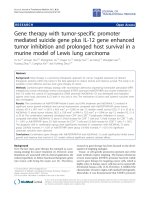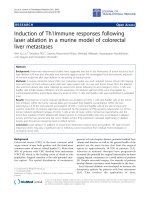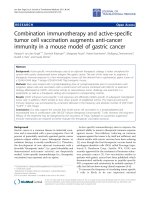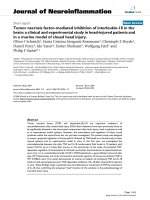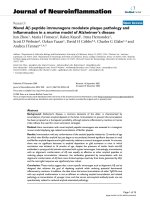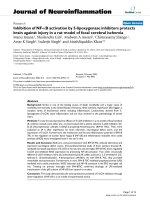Nonselective cyclooxygenase inhibition retards cyst progression in a murine model of autosomal dominant polycystic kidney disease
Bạn đang xem bản rút gọn của tài liệu. Xem và tải ngay bản đầy đủ của tài liệu tại đây (1.24 MB, 9 trang )
Int. J. Med. Sci. 2019, Vol. 16
180
Ivyspring
International Journal of Medical Sciences
International Publisher
2019; 16(1): 180-188. doi: 10.7150/ijms.27719
Research Paper
Nonselective Cyclooxygenase Inhibition Retards Cyst
Progression in a Murine Model of Autosomal Dominant
Polycystic Kidney Disease
Min Zhang1, Manakan B. Srichai2,4, Min Zhao2, Jian Chen2, Linda S. Davis2, Guanqing Wu2,3, Matthew D.
Breyer5 and Chuan-Ming Hao1,2,4
1.
2.
3.
4.
5.
Division of Nephrology, Huashan Hospital, Fudan University, Shanghai, China
Department of Medicine, Division of Nephrology, Vanderbilt University, Nashville, TN
Department of Cell and Developmental Biology, Vanderbilt University, Nashville, TN
VA Medical Center, Nashville, TN.
Biotechnology Discovery Research, Lilly Research Laboratories, Eli Lilly and Company, Indianapolis, Indiana 46225, USA
Corresponding author:
Chuan-Ming
Hao,
Division
of
Nephrology,
Huashan
Hospital,
Fudan
University,
Shanghai,
China.
Email:
© Ivyspring International Publisher. This is an open access article distributed under the terms of the Creative Commons Attribution (CC BY-NC) license
( See for full terms and conditions.
Received: 2018.06.07; Accepted: 2018.12.07; Published: 2019.01.01
Abstract
Aim: Autosomal dominant polycystic kidney disease is one of the most common genetic renal diseases.
Cyclooxygenase plays an important role in epithelial cell proliferation and may contribute to the mechanisms
underlying cyst formation. The aim of the present study was to evaluate the role of cyclooxygenase inhibition
in the cyst progression in polycystic kidney disease.
Method: Pkd2WS25/- mice, a murine model which harbors a compound cis-heterozygous mutation of the Pkd2
gene were used. Cyclooxygenase expression was assessed in both human and murine kidney specimens.
Pkd2WS25/- mice were treated with Sulindac (a nonselective cyclooxygenase inhibitor) or vehicle for 8 months
starting at three weeks age, and then renal cyst burden was assessed by kidney weight and volume.
Results: Cyclooxygenase-2 expression was up-regulated compared to control kidneys as shown by RNase
protection in human polycystic kidneys and immunoblot in mouse Pkd2WS25/- kidneys. Cyclooxygenase-2
expression was up-regulated in the renal interstitium as well as focal areas of the cystic epithelium (p<0.05).
Basal Cyclooxygenase-1 levels were unchanged in both immunohistochemistry and real-time PCR.
Administration of Sulindac to Pkd2WS25/- mice and to control mice for 8 months resulted in reduced kidney
weights and volume in cystic mice. Renal function and electrolytes were not significantly different between
groups.
Conclusion: Thus treatment of a murine model of polycystic kidney disease with Sulindac results in decreased
kidney cyst burden. These findings provide additional implications for the use of Cyclooxygenase inhibition as
treatment to slow the progression of cyst burden in patients with polycystic kidney disease.
Key words: ADPKD, COX2, PKD2, prostanoid, Sulindac
Introduction
Autosomal dominant polycystic kidney disease
(ADPKD) is one of the most common genetic diseases,
occurring in 1:400 to 1:1000 live births. In the U.S.
ADPKD accounts for an estimated 4.6% of patients
with end stage renal disease (ESRD) with an annual
ESRD incidence rate of about 6.9 per million [1].
Despite the ability to diagnose ADPKD early in life,
therapeutic options to forestall the predestined
progression to renal failure remain limited. By the age
of 65 years, about 45% to 70% of affected individuals
have developed ESRD [2]. Thus further investigations
into new therapies are critical to further impact the
prognosis of ADPKD. Several recent advances
including the availability of animal models which
mimic polycystic disease in humans have allowed a
better understanding of the pathological mechanisms
leading towards the progression of polycystic kidney
disease [3]. These advances have led to focus
Int. J. Med. Sci. 2019, Vol. 16
therapeutic efforts targeted to the molecular basis of
cyst formation and to the development of strategies
aimed to reduce the rate of cyst expansion.
Mutations in either the PKD1 or PKD2 gene
account for 85-90% and 10-15% of cases of ADPKD,
respectively [4]. ESRD develops as a consequence of
altered renal parenchyma resulting from the
progressive expansion of epithelial cysts and
subsequent remodeling of normal renal tissue
interposed between expanding cysts [5]. Strong
evidence also suggests that the progression of
ADPKD is affected by multiple genetic and
non-genetic modifiers, which is associated with
substantial intra-familial phenotypic variations of
ADPKD [6]. The identities of these modifiers and the
mechanism by which these modifiers affect polycystic
disease progress have not been completely defined.
Cyclooxygenase (COX) is a key enzyme involved
in
prostanoid
biosynthesis
which
converts
arachidonate to prostaglandin H2 (PGH2) which is
then converted to 5 major bioactive prostanoids via
distinct synthases. In the kidney, the two most
abundant prostanoids are prostaglandin E2 (PGE2)
and prostacyclin (PGI2), synthesized by microsomal
PGE synthase (mPGES) and PGI synthase (PGIS),
respectively [7]. COX exists as two major isoforms,
COX1 and COX2. COX2 represents an inducible early
growth response gene product that is up-regulated as
cells shift from quiescence (Go) to proliferation (G1)
[8]. COX derived prostanoids have been reported to
promote cell proliferation and contribute to the
development of intestinal polyposis in both mice and
humans [9]. Inhibition of COX2 either by selective or
non-selective inhibitors have been shown to markedly
reduce intestinal polyps in mice and in humans [10].
In the kidney, accelerated renal epithelial proliferation
has been uniformly demonstrated in ADPKD patients
and in animal models, with formation of micro-polyps
on the wall of kidney cysts [11]. Furthermore, elevated
COX2 enzyme activity has been reported in a rat
model of PKD [12]. Based on the similarities in cyst
formation between intestinal polyposis and polycystic
disease, we hypothesized that COX2 may be an
important mediator in promoting epithelial cell
proliferation and cyst expansion in polycystic kidney
disease and that cyclooxygenase inhibitors may slow
cyst progression. This hypothesis is supported by a
recent study showing that COX2 inhibition is
associated with reduced kidney cyst size in the Han:
SPRD-cy rat, a rat model of autosomal dominant
polycystic kidney disease [12]. Although the
phenotype of the Han: SPRD rat resembles human
ADPKD in many aspects, the gene responsible for
development of PKD does not share homology
relationships with PKD1 or PKD2 [13]. The present
181
studies examined the role of COX2 in a compound
cis-heterozygous murine model of human PKD2,
Pkd2WS25/- [14]. This model has targeted mutations to
the mouse homolog, Pkd2, which results in an
unstable allele, WS25, that can undergo homologous
recombination-based somatic rearrangements to form
a null allele [14].
Methods
Experimental animals and treatment. All animal
experiments were performed according to animal
protocols approved by the Animal Care Use
Committee at Vanderbilt University School of
Medicine. Pkd2+/- mice were intercrossed with either
Pkd2+/WS25 or Pkd2WS25/WS25 animals (kindly provided
by Drs. Stefan Somlo and Guanqing Wu) to obtain
compound cis-heterozygous Pkd2WS25/- mice [14].
Pkd2+/WS25 and Pkd2+/+ mice served as controls. All
mice were housed in regular cages under normal 12hr
light/dark cycles and were fed a standard rodent diet.
At sacrifice, kidneys were harvested and snap frozen.
Kidneys were also cut and fixed in 4%
paraformaldehyde for paraffin sectioning. Blood urea
nitrogen (BUN), hematocrit, and serum electrolytes
were measured by a commercially available assay
(Heska-iSTAT).
Pkd2WS25/- mice were treated with Sulindac (12 to
14 mg/kg body weight/day) [15, 16] or vehicle for 8
months starting at three weeks age. Sulindac was
added to mouse chow (0.006%) and stored at 4°C. At
this concentration, plasma concentration of Sulindac
sulfide (the active component of Sulindac) was
estimated to be 〜 0.5μg/ml [15]. For Sulindac sulfide,
this concentration resulted in 〜 50% inhibition of
COX-1 and < 50% inhibition of COX-2 in human
whole blood assays [17]. Fresh food was prepared
monthly. At the end of the study, renal cyst burden
was assessed by kidney weight and kidney volume
which was calculated by the standard formula for a
modified ellipsoid (4/3π x (anteroposterior
diameter/4 + width/4)2 x length/2).
Renal volume =
2
4
anteroposteriordiameter width length
π ×
+
×
3
4
4
2
Human kidney tissue. Kidney nephrectomy
specimens from adult ADPKD and control patients
undergoing nephrectomy were obtained from
Vanderbilt University surgical pathology with IRB
approval. Total RNA and paraffin-embedded kidney
sections were prepared.
FITC-inulin measurement of GFR. Glomerular
filtration rate (GFR) was assessed according to
Int. J. Med. Sci. 2019, Vol. 16
clearance kinetics of plasma FITC-inulin following a
single bolus injection. Briefly, 5% FITC-inulin was
prepared by dissolving FITC-insulin (Sigma) in 0.9%
NaCl.
Dialyzed
FITC-inulin
was
injected
retro-orbitally (3.74µl/g body weight) under light
anesthesia induced using Isoflurane (Baxter
Pharmaceutical Products Inc., Deerfield, IL).
Approximately 20µl of blood was collected via
saphenous vein at 3, 7, 10, 15, 35, 55, 75 minutes post
FITC-inulin injection. 10µl of plasma was used for
FITC determination using a Fluoroscan Ascent FL
(Labsystems, FIN-00811 Helsinki, Finland), with 485
nm excitation, and read at 538 nm emission. GFR was
calculated according to two compartment clearance
models using the formula: GFR = I/(A/a + B/b),
where I is the amount of FITC-inulin delivered by the
bolus injection; A and B are the y -intercept values of
the two decay rates, and a and b are the decay
constants for the distribution and elimination phases,
respectively.
Western blotting. Whole kidney lysate was
prepared by homogenizing kidneys in RIPA buffer
(1% Triton X-100, 0.5% deoxycholate, 1% SDS, 150mM
NaCl, 50mM Tris-Hcl (pH 8), 2mM EDTA, and 1mM
sodium orthovanadate) with protease cocktail
inhibitors (Complete Mini, Roche Diagnostics) using a
homogenizer (PowerGen 700, Fisher Scientific).
Samples were incubated on ice, passed through a 25g
syringe, and centrifuged at 4°C for 30min 10000g.
Supernatant was collected and protein levels
measured (BCA, Sigma). Protein was electrophoresed
on a 10% Tris-Hcl SDS gel (BioRad) and transferred to
nitrocellulose membrane overnight. Membranes were
blocked in blocking buffer (150 mM NaCl, 50 mM
Tris, 0.05% Tween 20, and 5% Carnation nonfat dry
milk, pH 7.5) for 1hr at room temperature, and
incubated with affinity-purified primary COX2 Ab
(1:1000, 160126 Cayman) or β-actin (1:10000 Sigma) in
blocking buffer overnight at 4°C. After washing three
times in TBST (50 mM Tris, pH 7.5, 150 mM NaCl,
0.05% Tween 20), the membranes were incubated
with horseradish peroxidase-conjugated secondary
antibody (1:5000 for anti-mouse and 1:10000 for
anti-rabbit) for 1hr at room temperature, followed by
three 15-min washings. Antibody labeling was
visualized by addition of chemiluminescence reagent
(Renaissance, DuPont-New England Nuclear, Boston,
MA), and the membrane was exposed to Kodak
XAR-5 film and developed.
Immunohistochemistry: Paraffin kidney sections
were prepared and stained for COX2 1:1000 (Cayman,
160106) and mPGES1 (Cayman, 160140) using
standard protocol. In general at the termination of an
experiment, mice were deeply anesthetized with
Nembutal (70mg/kg ip) and the right kidney was
182
clamped and removed for immunoblot. Mice were
then exsanguinated with 50mL/100g heparinized
saline (0.9% NaCl, 2U/mL heparin, 0.02% sodium
nitrite) through a transcardial aortic cannula and the
left kidney fixed by retrograde perfusion through the
heart with 4% paraformaldehyde. Tissue blocks were
post-fixed overnight in 4% paraformaldehyde and
subsequently dehydrated through a graded series of
ethanol, embedded in paraffin, sectioned (4µm), and
mounted on glass slides. Internal controls and
comparisons were facilitated by creating compound
blocks with multiple specimens that were sectioned
and stained together. COX2 was immunolocalized
with affinity-purified rabbit polyclonal anti-murine
COX2 peptide (residues 570-598) (Cayman Chemicals,
160106) at a dilution of 1:1000. Staining was localized
using a biotinylated anti-rabbit secondary antibody.
Biotin was identified using streptavidin coupled to
horseradish peroxidase and visualized with
diaminobenzidine (Vector Vectastain ABC kit).
Sections were viewed and imaged with a Zeiss
Axioskop and Spot-Cam digital camera (Diagnostic
Instruments).
In-situ hybridization. In-situ hybridization was
performed as previously described [18]. Briefly, a
35S-labeled antisense riboprobe generated from the
597-bp PCR fragment of mouse or 471-bp PCR
fragment of human 3' untranslated region of the
COX2 cDNA was hybridized to the tissue sections
and then washed as previously described. The slides
were dehydrated with graded ethanol containing 300
mM ammonium acetate, dipped in emulsion (Ilford
K5; Knutsford, Cheshire, UK) and exposed for 4-5
days at 4°C. After developing in Kodak D-19, the
slides were counterstained with hematoxylin.
Photomicrographs were taken using a Zeiss Axioskop
microscope with either dark field or bright field
optics.
Nuclease protection. A 471-bp riboprobe for
nuclease protection was generated from a portion of
the 3’region of the human COX2 cDNA. A 250-bp
riboprobe was generated from a PCR fragment of
human β-actin. Antisense cRNA was transcribed in
the presence of [α-32P]-UTP 400–800 Ci/mmol
(MAXIscript; Ambion, Austin, Texas, USA) and
hybridized to 30 µg of total cellular RNA at 42°C for
14–18 hours. In all cases total cellular RNA was
prepared using chloroform/phenol extraction using
commercial reagents (Molecular Research Center Inc.,
Cincinnati, Ohio, USA). Ribonuclease A digestion was
carried out at 37°C for 30 minutes. Protected
fragments were separated on a 6% polyacrylamide/7
M urea gel, followed by autoradiography.
Statistical analysis. All statistical analyses were
performed with Prism Version 4.0a for Macintosh.
Int. J. Med. Sci. 2019, Vol. 16
183
One-way ANOVA were performed for total cyst
burden comparison.
2A, 2B). Localization to these areas was confirmed by
in situ hybridization (Figure 2C, 2D).
Results
COX and prostanoid synthase expression in
cystic kidney of Pkd2 mice.
COX2 expression is up-regulated in polycystic
kidneys from ADPKD patients.
To assess COX2 expression levels in ADPKD
kidneys, nuclease protection assay was performed. As
shown in Figure 1, COX2 mRNA expression in
diseased ADPKD kidneys was substantially
up-regulated (Lanes 4-5) compared to normal,
non-cystic kidneys (Lanes 1-3).
Figure 1. Nuclease protection assay for COX2 transcript expression. Lanes 1-3
represent 3 separate normal control adult human kidneys. Lanes 4-5 represent 2
separate adult ADPKD human kidneys. 30µg total RNA loaded per lane.
Immunohistochemistry for COX2 localized
COX2 immunoreactivity to the renal interstitium as
well as to the epithelial cells lining the cysts (Figure
Kidney COX expression in a mouse model of
human PKD2, Pkd2WS25/-, was examined via
immunoblot and real-time PCR. Cystic kidneys from
mice
had
increased
COX2
Pkd2WS25/immunoreactivity compared to non-cystic kidneys
from Pkd2+/WS25 mice (Figure 3A, p<0.05). This
difference in COX2 expression level was also noted at
the mRNA transcript level by real-time PCR, whereas
no differences were observed in COX1 (Figure 3B). In
addition, the prostaglandin synthases, mPGES1 and
PGIS, were elevated in Pkd2WS25/- mice by real-time
PCR (Figure 3B) (n=4, p<0.01); no differences were
observed in cytosolic PGE synthase (cPGES).
Localization of COX2 mRNA transcript by in situ
hybridization demonstrated expression in cystic
epithelial cells and in the interstitium, similar to the
findings in human ADPKD kidneys (Figure 4B).
Control kidneys had nearly absent COX2 mRNA
expression (Figure 4A). Localization of mPGES1 by
immunohistochemistry and in situ hybridization
demonstrated expression primarily along the cystic
epithelia cells (Figure 4C-F). Taken together, these
studies suggest COX2 and the downstream
prostanoids PGE2 and PGI2 may be associated with
cyst development in Pkd2WS25/- mice.
Figure 2. COX2 protein localization in kidneys from ADPKD patients. (A-B) Immunohistochemistry reveals COX2 reactivity in the interstitium (A) and epithelial cyst lining (B).
(C-D) In-situ hybridization for COX2 mRNA transcript. 200X brightfield.
Int. J. Med. Sci. 2019, Vol. 16
184
Figure 3. (A) Immunoblot for COX2 and β-actin in Pkd2+/WS25 and Pkd2WS25/- kidneys. 30µg protein lysate loaded per lane. * p<0.05. (B) Real-time PCR for COX and
downstream prostanoid synthases in Pkd2WS25/- kidneys vs. control kidneys. N=4, ** p<0.01.
Figure 4. Localization of COX2 and mPGES1 mRNA transcript in control Pkd2+/WS25 kidneys and cystic Pkd2WS25/- kidneys. (In-situ hybridization) (A-B) COX2 mRNA transcript
in control Pkd2+/WS25 kidneys (A) and cystic Pkd2WS25/- kidneys (B). mPGES1 transcript in control Pkd2+/WS25 kidneys (C,E) and cystic Pkd2WS25/- (D,F) kidneys.
Immunohistochemistry (C,D), In-situ hybridization (E,F). 200X darkfield (A-B, E-F); 200x brightfield (C-D).
Int. J. Med. Sci. 2019, Vol. 16
Effect of cyclooxygenase inhibitor on cyst
development and renal function.
To determine the effects of COX inhibition on the
progression of cyst growth in polycystic kidney
disease, Pkd2WS25/- cystic mice were treated with
Sulindac, a nonselective oral COX inhibitor. Kidney
volumes of Pkd2WS25/- mice (1.19±0.83 cm3, n=9, 4
males) were significantly larger than that of control
Pkd2+/WS25 and PKD2+/+ mice (0.54±0.07 cm3, n=21, 10
males, p<0.01, Figure 5A). Sulindac treatment
significantly reduced the kidney volumes of
Pkd2WS25/- mice (0.74±0.29 cm3, n=8, 3 males) when
compared to vehicle-treated Pkd2WS25/- mice (p<0.05).
Similar results were obtained when renal cyst burden
was assessed by kidney weight (Figure 5B).
185
however, these differences were not statistically
significant (Figure 6).
Table 1. Blood electrolyte and chemical data of control
Pkd2+/WS25 kidneys and cystic Pkd2WS25/- kidneys treated with
vehicle or Sulindac. No statistically different was observed.
Na (mEq/L)
K (mEq/L)
Cl (mEq/L)
Glu (mEq/L)
pH
TCO2
BUN (mg/dl)
Hct (%)
control
150±1.9
4.2±0.4
119±4.1
185±48
7.30±0.03
22±2.9
21±3.9
34±3.6
PKD2+V
150±2.9
4.6±0.8
123±5.0
180±35
7.31±0.07
23±4.2
26±5.8
28±3.6
PKD2+SU
151±6.4
4.9±0.8
121±6.6
225±94
7.30±0.04
24±2.4
26±7.2
30±2.5
PKD2+V: PKD2WS25/-+vehicle; PKD2+SU: PKD2WS25/-+Sulindac
Figure 6. GFR as assessed by FITC-inulin clearance. GFR in WT (8±1.60 l/min/g,
n=4), vehicle-treated Pkd2WS25/- (7.26±1.22 l/min/g, n=3), and Sulindac-treated
Pkd2WS25/- (6.89±0.52 l/min/g, n=3) mice were not statistically different.
Discussion
Figure 5. Combined kidney volumes (A) and weights (B) following 8mo treatment
with vehicle or Sulindac. WT (n=21) represents kidneys from either Pkd2+/WS25 or
Pkd2+/+ mice. (A) Kidney volume in vehicle-treated Pkd2WS25/- mice (n=9) were
significantly elevated when compared to WT kidneys (** p<0.01) and when compared
to Sulindac-treated Pkd2WS25/- mice (n=8) (# p<0.05). Combined kidney volumes of
WT, Vehicle, Sulindac: 0.54±0.07, 1.19±0.83, 0.74±0.29. (B) Kidney weights were
significantly higher in vehicle-treated Pkd2WS25/- kidneys when compared to WT
kidneys (* p<0.01). Sulindac-treated Pkd2WS25/- mice had a trend towards lower
weights compared to vehicle-treated Pkd2WS25/- although this did not approach
statistical significance. Again there were no statistical differences in kidney weights
between WT kidneys and Sulindac-treated Pkd2WS25/- kidneys.
Table 1 shows the results of whole blood
electrolytes and BUN as measured by i-STAT. There
were no significant differences in BUN, hematocrit, or
electrolytes between the three groups (Table 1).
FITC-inulin clearance performed at the end of
treatment revealed a slight decrease in GFR in
Pkd2WS25/- mice as compared to control mice,
Renal cystic diseases represent an important
cause of renal insufficiency and renal failure [19, 20].
Despite major advances in understanding the genetic
basis for disease [14, 21, 22], the pathogenesis of cyst
formation and expansion is incompletely understood.
Furthermore, therapeutic medical interventions that
can block kidney cyst expansion are currently limited.
Animal studies have shown potential therapeutic
roles for vasopressin V2 receptor antagonists and
mTOR inhibitors in retarding cyst growth [23, 24].
More recently, the COX2 inhibitor, NS-398, was
shown to reduce cyst growth in the Han: SPRD rats
[12]. In the current study, we have examined the role
of cyclooxygenase in human ADPKD and in a murine
model of human PKD2, Pkd2WS25/-. We show
increased COX2 expression in cystic kidneys from
both human ADPKD and Pkd2WS25/- mice as well as
increased expression of the downstream prostanoid
synthases, mPGES1 and PGIS, in Pkd2WS25/- kidneys.
Treatment with Sulindac, a nonselective COX
inhibitor, significantly retarded increases in kidney
volume in Pkd2WS25/- mice. Taken together, these data
suggest that COX-derived prostanoids may represent
potential therapeutic targets for ADPKD.
Int. J. Med. Sci. 2019, Vol. 16
COX-derived
prostaglandins
have
been
documented to play important roles in many
physiological and pathological processes, such as
maintenance of fluid homeostasis and vascular tone,
inflammation, angiogenesis, and cell proliferation.
Non-selective COX inhibitors and COX2 inhibitors
have been shown to inhibit cell proliferation and
reduce the size and number of intestinal polyps in
both humans with familial adenomoatous polyposis
(FAP) and in animal models which mimic the disease.
Accelerated cell proliferation has invariably been
detected in renal cystic epithelial cells, and
hyperplastic polyps are commonly observed within
the epithelia lining the cyst wall [11]. A two-hit
mechanism of cyst formation has been proposed
which may account for the focal nature of cyst
development [25]. The Pkd2WS25/- murine model of
ADPKD supports the two-hit hypothesis, which was
originally proposed by Knudsen to explain childhood
tumors.
As with ADPKD, FAP also represents an
autosomal dominant disease associated with benign
(at least initially) but accelerated epithelial
proliferation of intestinal cells. Two groups identified
the relevant mutation in a novel gene designated APC
(adenomatous polyposis coli). Polyps in FAP also
develop sporadically as a result of loss of
heterozygosity (LOH) due to somatic cell mutations in
the remaining normal somatic cell APC allele.
Furthermore there is evidence that the signaling
pathways activated by the APC protein and
polycystin-1 may be similar as both proteins may
interact with the β-catenin-nuclear signaling pathway,
altering gene expression and activating cell
proliferation. These considerations provide a
conceptual basis for utilizing similar approaches for
the treatment of FAP and ADPKD. This hypothesis is
supported by the present study which revealed
increased COX2 expression in cystic kidneys of both
human ADPKD and Pkd2WS25/- mice and reduced
kidney volume in cystic mice following COX
inhibition. We chose to study cyst growth in a murine
model of PKD, Pkd2WS25/- because unlike other rodent
models, this one more closely mimics human PKD
with the second hit model. In this murine model,
bilateral cyst formation occurs in 100% of animals by
10-11 wk age [14]. As in human ADPKD, formation of
kidney cysts in this model is associated with renal
failure and early death [14]. But to our experience and
according to literatures, the decline of renal function
in this mouse line is variable [14, 26]. Some studies
shown Pkd2WS25/- mice had no significant BUN
increase even at the age of 5 months [26]. Longitudinal
FISP-MRI analyses of changes in cyst volumes were
performed in this model over 15 months. The result
186
shown that Pkd2WS25/− mice had significant increases
in kidney weights at 4 months of age. Interestingly,
between 4 and 12 months of age, there was no
accelerated progression of kidney growth [27]. We
chose to evaluate the effect of COX inhibitor in this
model for 8 months in order to exclude the variety of
renal function decline.
To examine whether COX derived prostanoids
play a role in cyst growth in Pkd2 mice, Pkd2WS25/mice were treated with Sulindac, which has been
reported
to
significantly
inhibit
colorectal
adenomatous polys in both rodent models and in
patients with FAP [28-30]. Celecoxib (selective COX2
inhibitor) use resulted in a modest reduction of
colorectal polyps, but is no longer US FDA-approved
for this indication, due to lack of complete follow-up
studies. Treatment was started at 3 weeks age to avoid
renal dysgenesis caused by COX2 inhibition [31].
Sulindac treatment resulted in a significant reduction
in kidney volume and did not significantly alter BUN
or GFR levels. However, none of the polycystic
animals, either treated or untreated, developed
evidence for ESRD, likely because the disease is
slowly progressive and renal function tends to
deteriorate at later stages of the disease.
In ADPKD, changes in cyst volume occur prior
to renal dysfunction. Cyst development and
time-dependent structural disruption of renal
architecture plays a central role in the genesis of PKD
and cyst growth is a key predictor of deterioration of
renal function. Despite the lack of an effect on renal
function, the change of kidney volume is likely to
have long-term beneficial effects on disease
progression.
Furthermore, a concern raised regarding the use
of NSAIDs is their potential to cause renal damage in
patients with renal insufficiency. In this study, no
significant difference of BUN was observed between
vehicle treated group and Sulindac treated group.
These results show the need for further investigation
into the longer-term effects and side effects of NSAIDs
on cystic renal disease progression.
The mechanisms by which COX derived
prostanoids modulate cyst growth in the cystic kidney
have not yet been defined. The present study showed
increased mPGES1 and PGIS expression in the cystic
kidney, consistent with the recent report which
showed increased levels of PGE2 and PGI2 in the
cystic kidney [32]. These findings support a potential
role for PGE2 and/or PGI2 in the pathogenesis of cyst
growth. In addition, both PGE2 and PGI2 can increase
intracellular cAMP levels through the EP2/EP4 and
IP receptors respectively, and cAMP has been
suggested to promote cyst growth [33]. The EP4
receptor has also been reported to activate the
Int. J. Med. Sci. 2019, Vol. 16
PI3K/AKT pathway, which may lead to activation of
mTOR, inhibition of which has been reported to
reduce cyst growth [24]. Whether these pathways are
responsible for the cyst growth in ADPKD remains to
be explored.
Epithelial-stromal interactions and induction of
angiogenesis have emerged as important concepts in
the pathogenesis of ADPKD [34]. COX2 has been
suggested to promote angiogenesis in intestinal
polyps and in colon cancer. Whether COX derived
prostanoids enhance cyst expansion through their
effect on angiogenesis remains to be explored. High
levels of mPGES1 were detected in renal cystic
epithelial cells where COX1 is normally expressed
[35], thus we speculate that PGE2 synthesis from
epithelial cells derived via the COX1-mPGES pathway
may also be involved in cyst growth.
In conclusion, the present study shows that
COX2 expression is increased in cystic kidneys from
human ADPKD and a murine Pkd2WS25/- compared to
non-cystic control kidneys. Expression of the
downstream prostanoids mPGES and PGIS were also
notably increased in Pkd2WS25/- kidneys, the
significance of which is unclear. COX inhibition with
Sulindac significantly reduced kidney size of the Pkd2
mice, suggesting that the COX pathway is a potential
therapeutic target for ADPKD.
Supplementary Material
Supplementary figure.
/>
Acknowledgements
Pkd2+/WS25 and Pkd2WS25/WS25 animal models
were kindly provided by Drs. Stefan Somlo and
Guanqing Wu.
Funding
This study was supported by the National
Natural Science Foundation of China (grants
81130075, 31471101 and 81400711) and 985 project 985
III-YFX0302. This study was supported by NIDDK
grants DK071876 and DK074116 (to C.M.Hao).
Ethical approval
All animal experiments were performed
according to animal protocols approved by the
Animal Care Use Committee at Vanderbilt University
School of Medicine.
Competing Interests
The authors have declared that no competing
interest exists.
187
References
1.
2.
3.
4.
5.
6.
7.
8.
9.
10.
11.
12.
13.
14.
15.
16.
17.
18.
19.
20.
21.
22.
23.
24.
25.
26.
27.
28.
29.
Collins AJ, Foley RN, Herzog C, et al. US Renal Data System 2010 Annual Data
Report. Am J Kidney Dis. 2011; 57(1 Suppl 1): A8, e1-526.
Lentine KL, Xiao H, Machnicki G, et al. Renal function and healthcare costs in
patients with polycystic kidney disease. Clin J Am Soc Nephrol. 2010;
5(8):1471-9.
Guay-Woodford LM. Murine models of polycystic kidney disease: molecular
and therapeutic insights. Am J Physiol Renal Physiol. 2003; 285(6):F1034-49.
Rossetti S, Consugar MB, Chapman AB, et al. Comprehensive molecular
diagnostics in autosomal dominant polycystic kidney disease. J Am Soc
Nephrol. 2007; 18(7):2143-60.
Grantham JJ: Mechanisms of progression in autosomal dominant polycystic
kidney disease. Kidney Int. 1997; 63 (Suppl):S93-7.
Rossetti S, Harris PC. Genotype-phenotype correlations in autosomal
dominant and autosomal recessive polycystic kidney disease. J Am Soc
Nephrol. 2007; 18(5):1374-80.
Hao CM, Breyer MD. Roles of lipid mediators in kidney injury. Semin
Nephrol. 2007; 27(3):338-51.
Dubois RN, Abramson SB, Crofford L, et al. Cyclooxygenase in biology and
disease. FASEB J. 1998; 12(12):1063-73.
Hla T, Bishop-Bailey D, Liu CH, et al. Cyclooxygenase-1 and -2 isoenzymes.
Int J Biochem Cell Biol. 1999; 31(5):551-7.
Rostom A, Dube C, Lewin G, et al. Nonsteroidal anti-inflammatory drugs and
cyclooxygenase-2 inhibitors for primary prevention of colorectal cancer: a
systematic review prepared for the U.S. Preventive Services Task Force. Ann
Intern Med. 2007; 146(5):376-89.
Bernstein J, Evan AP, Gardner KD Jr. Epithelial hyperplasia in human
polycystic kidney diseases. Its role in pathogenesis and risk of neoplasia. Am J
Pathol. 1987; 129(1):92-101.
Ibrahim NH, Gregoire M, Devassy JG, et al. Cyclooxygenase product
inhibition with acetylsalicylic acid slows disease progression in the
Han:SPRD-Cy rat model of polycystic kidney disease. Prostaglandins Other
Lipid Mediat. 2015; 116-117:19-25.
Nauta J, Goedbloed MA, Luider TM, et al. The Han:SPRD rat is not a genetic
model of human autosomal dominant polycystic kidney disease type 1. Lab
Anim. 1997; 31(3): 241-7.
Wu G, D'Agati V, Cai Y, et al. Somatic inactivation of Pkd2 results in
polycystic kidney disease. Cell.1998; 93(2):177-88.
Lal G, Ash C, Hay K, et al. Suppression of intestinal polyps in Msh2-deficient
and non-Msh2-deficient multiple intestinal neoplasia mice by a specific
cyclooxygenase-2 inhibitor and by a dual cyclooxygenase-1/2 inhibitor.
Cancer Res. 2001; 61(16):6131-6.
Oshima M, Dinchuk JE, Kargman SL, et al. Suppression of intestinal polyposis
in Apc delta716 knockout mice by inhibition of cyclooxygenase 2 (COX-2).
Cell. 1996; 87(5):803-9.
Brideau C, Kargman S, Liu S, et al: A human whole blood assay for clinical
evaluation of biochemical efficacy of cyclooxygenase inhibitors. Inflamm Res.
1996; 45(2):68-74.
Breyer MD, Jacobson HR, Davis LS, et al: In situ hybridization and localization
of mRNA for the rabbit prostaglandin EP3 receptor. Kidney Int. 1993;
44(6):1372-8.
Grantham JJ, Chapman AB, Torres VE. Volume progression in autosomal
dominant polycystic kidney disease: the major factor determining clinical
outcomes. Clin J Am Soc Nephrol. 2006; 1(1):148-57.
Torres VE, Harris PC, Pirson Y. Autosomal dominant polycystic kidney
disease. Lancet. 2007; 369(9569):1287-1301.
Nauli SM, Alenghat FJ, Luo Y, et al. Polycystins 1 and 2 mediate
mechanosensation in the primary cilium of kidney cells. Nat Genet. 2003;
33(2):129-37.
Watnick T, He N, Wang K, et al. Mutations of PKD1 in ADPKD2 cysts suggest
a pathogenic effect of trans-heterozygous mutations. Nat Genet. 2000;
25(2):143-4.
Tao Y, Kim J, Schrier RW, et al. Rapamycin markedly slows disease
progression in a rat model of polycystic kidney disease. J Am Soc Nephrol.
2005; 16(1):46-51.
Wahl PR, Serra AL, Le Hir M, et al. Inhibition of mTOR with sirolimus slows
disease progression in Han:SPRD rats with autosomal dominant polycystic
kidney disease (ADPKD). Nephrol Dial Transplant. 2006; 21(3):598-604.
Qian F, Watnick TJ, Onuchic LF,et al. The molecular basis of focal cyst
formation in human autosomal dominant polycystic kidney disease type I.
Cell. 1996; 87(6):979-87.
Roix J, Saha S: TNF-alpha blockade is ineffective in animal models of
established polycystic kidney disease. BMC Nephrol. 2013; 25; 14:233.
Doctor RB, Serkova NJ, Hasebroock KM, et al. Distinct patterns of kidney and
liver cyst growth in pkd2(WS25/-) mice. Nephrol Dial Transplant. 2010;
25(11):3496-504.
Keller JJ, Offerhaus GJ, Hylind LM, et al. Rectal epithelial apoptosis does not
predict response to sulindac treatment or polyp development in
presymptomatic familial adenomatous polyposis patients. Cancer Epidemiol
Biomarkers Prev. 2002; 11(7):670-1.
Giardiello FM, Yang VW, Hylind LM, et al. Primary chemoprevention of
familial adenomatous polyposis with sulindac. N Engl J Med. 2002;
346(14):1054-9.
Int. J. Med. Sci. 2019, Vol. 16
188
30. Samadder NJ, Neklason DW, Boucher KM, et al. Effect of Sulindac and
Erlotinib vs Placebo on Duodenal Neoplasia in Familial Adenomatous
Polyposis: A Randomized Clinical Trial. JAMA. 2006; 315(12):1266-75.
31. Komhoff M, Wang JL, Cheng HF, et al. Cyclooxygenase-2-selective inhibitors
impair glomerulogenesis and renal cortical development. Kidney Int. 2000;
57(2):414-22.
32. Warford-Woolgar L, Peng CY, Shuhyta J, et al. Selectivity of cyclooxygenase
isoform activity and prostanoid production in normal and diseased
Han:SPRD-cy rat kidneys. Am J Physiol Renal Physiol. 2006; 290(4):F897-904.
33. Torres VE, Wang X, Qian Q, et al. Effective treatment of an orthologous model
of autosomal dominant polycystic kidney disease. Nat Med. 2004;10(4): 363-4.
34. Qian Q, Harris PC, Torres VE: Treatment prospects for autosomal-dominant
polycystic kidney disease. Kidney Int. 2001; 59(6): 2005-2022.
35. Qi Z, Hao CM, Langenbach RI, et al. Opposite effects of cyclooxygenase-1 and
-2 activity on the pressor response to angiotensin II. J Clin Invest. 2002;
110(1):61-9.


